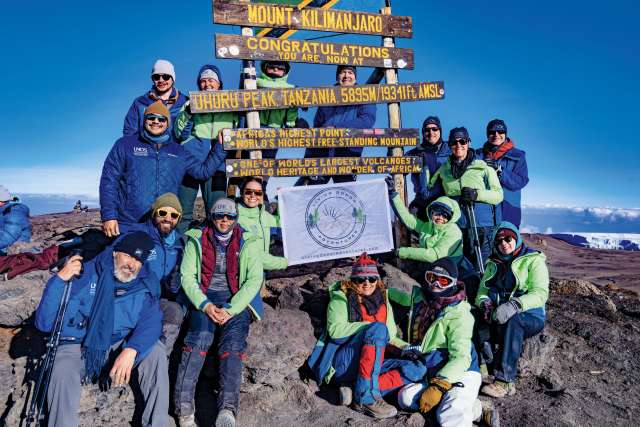The first time I climbed Tanzania’s Mt. Kilimanjaro was in 2015. It is one of the Seven Summits — the highest peaks on each continent — and because its base starts at a lower elevation than Mt. Everest’s, it actually is, at 19,341 feet above sea level, the highest freestanding mountain on Earth.
I went back in March of 2023 with a group of living organ donors who created an organization called Living Donor Adventures to demonstrate that you can still be active and adventurous after donating an organ. When I asked one of the climbers why he donated a kidney, he said, “I have two and only need one. Why wouldn’t I share the extra one?”
It is an important and urgent message. As surgical director of the UCLA Health Kidney Transplant Program, I know the statistics all too well. There are roughly 500,000 people in the United States on dialysis, with more than 100,000 waiting for a transplant. Every month, another 3,000 or so new patients are added to the transplant waiting list, and roughly 13 people die each day while waiting for a donor organ.
The need for donor kidneys is acute and wait times for deceased-donor kidneys are long — the national median is upwards of 3½ years, and up to 10 years in Los Angeles. More living donors, which now account for less than half of all kidney transplants in the United States, could help to alleviate this bottleneck. But many people believe that if they donate an organ like a kidney, their life will be forever altered, and their activities limited.
And here was this group of living organ donors preparing to climb Kilimanjaro, setting out to prove them wrong.
When I learned of this endeavor, I wanted to be a part of it. I reached out to the guide who led my climb eight years ago, Stanley Mariki, with whom I’d stayed in contact over the years. “Would you organize a parallel climb with the Living Donors Adventure Group?” I asked him. There were seven of us, including two UCLA Health nurses, who joined 32 living kidney and liver donors, along with almost 100 porters and guides.
The plan was to reach the summit on March 9, World Kidney Day. We took the longer, eight-day route up the mountain, to better adjust to the altitude. When I made the trek in 2015, I nearly ran out of gas by the time we reached the rim — Kilimanjaro is a dormant volcano — at 18,500 feet, but I was able to press on to the true summit. I’m older now, and this time when we got to the rim, I really felt the effects of altitude and decided not to push myself further.
Obviously, I wanted to make it to the summit — everybody else got there — but for me, the mission this time was to promote the fact that living organ donors can have an active and adventurous life after giving a piece of themselves to help another human being.
And, also, to help support Stanley.
I knew that with the COVID-19 pandemic he’d been struggling to make a living, and I’d told him that since we were coming all the way to Africa, my friends and I also wanted to do a safari, which he organized for us, as well. Stanley has three children — an 8-year-old daughter, a boy who is 7 and a toddler of 2. I asked if his kids had ever been on a safari. They had not, so I told him that I’d pay for them to come along.
For them, it was an experience of many firsts: their first safari, the first time they stayed in a hotel, the first time they used binoculars, the first time they took pictures with a 35-millimeter camera with a zoom lens. They were in heaven.

Me, too. I learned so much from Stanley on this trip, about his family history and life in Tanzania. I found it all fascinating and moving. That he shared his life with me in this way was eye opening, showing me how we really are a global village and that what we do in the United States ripples out to peoples around the world, for better or worse.
As citizens of a wealthy nation, we in the U.S. have opportunities to help people in other parts of the world. It is easy to send a check, but another impactful way is to directly support their livelihood. By engaging Stanley, it provided him with the resources to buy some land and build a foundation for his house.
For me, the greatest impact was bringing my friends to meet Stanley and his family, and for them to hear stories about his life and the history of Tanzania. And there was the impact of meeting so many living organ donors and seeing their motivation to not only give a life-saving gift, but also to promote the fact that as individuals we each can make a difference.
Sure, getting to the summit would have been a personal victory, but having the opportunity to bring all these people together was the real win.
Dr. H. Albin Gritsch is the John Jergens Chair in Kidney Transplantation in the David Geffen School of Medicine at UCLA, and he would happily speak with anyone interested in visiting Tanzania ().

